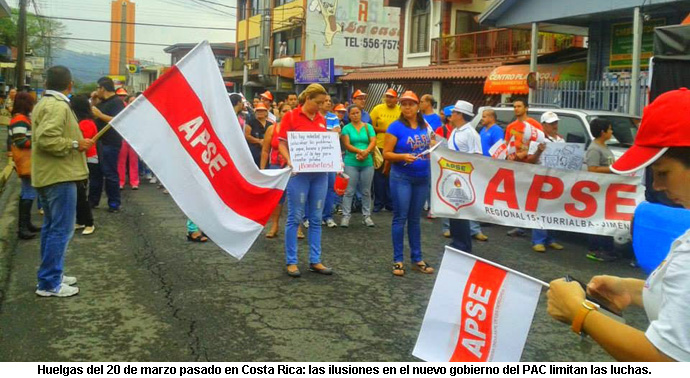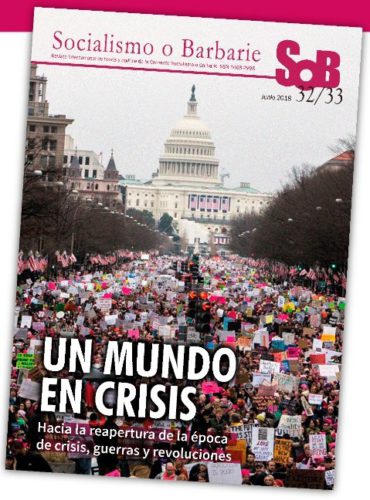
Compartir el post "The unwritten chapters of Lenin’s “What is to be done?” – The building of vanguard organizations in conditions in which the working class is not socialist yet"
During a recent tour in Central America there was an extremely rich debate with our comrades in Honduras and Costa Rica. The debate concerned the current building conditions of revolutionary organizations internationally speaking but paying special attention to Central America.
In said exchange we insisted –in a pedagogic way- on the fact that Lenin’s ‘What is to be done?’ “lacked” a whole chapter about the specific laws of development of vanguard organizations in conditions in which the proletariat is not socialist yet. This is a historic circumstance that the Russian revolutionary did not have to deal with, but it is still the one that prevails today as we enter a period of the “restart» of the historic experience of the exploited and the oppressed.
Our problems are not the ones Lenin had.
As we have been pointing out, one of the principal exchanges we had with our Central American comrades revolved around the general conditions of the construction of our organizations in comparison to other historical periods.
Let’s begin with the basic fact that these conditions have been improving throughout the current cycle of popular rebellions in which a new militant generation is emerging. However, such conditions are still very different from those that existed a century ago in terms of the level of subjectivity reached by the working class; which allows us to explain many of the “regularities” or “construction laws” of our organizations in the present day.
At the beginning of the XX century, mostly in Europe, there was a socialist working class movement which was organized in mass social democratic parties which were part of the II International. The main party was the German Social Democracy (SPD, Social Democratic Party) grouping a million affiliates, running unions of 3 or 4 million members, editing 20 or 30 newspapers and had a Parliament Bloc of 30 to 40 congressmen. Its size was such it was considered a “State within the State”.
If in the German social democracy- the party that ran the II International- the magnitude was counted by millions, in the “small” circles of the Russian socialism the numbers reached “only” tens of thousands (the sum of the Bolshevik and Menshevik tendencies in the first decade of the century oscillated around 80.000 militants). It is because of this that the German leaders looked down on the Russians, and the reason why even Lenin considered himself as a “disciple” of Bebel and Kautsky [1] , who were respectively the main leader and the main theorist of the German party [2] .
Bolshevism had the good fortune of being able to, not only build itself as the left wing of this socialist mass movement, but also to end up being its revolutionary fraction. Fraction which “saved the honor” of the international socialist movement with the taking of power in 1917, while the crème de la crème of German, Austrian, Italian and French social democracy degenerated into “social-chauvinism” by taking the side of their own bourgeoisie in the inter-imperialist butchery of World War I [3] .
In any case, those historic conditions were very different from the ones the revolutionary socialism had to face from the 1930’s with the simultaneous emergence of Stalinism and Nazism, the “midnight of the XX century”. A historic period in which swimming against the current had to be learned and whose negative consequences can be felt even nowadays; a phenomenon which “overlaps” with the emergence of a new fighting generation that is coming from the current cycle of popular rebellions [4] .
Now, if we look back at Lenin and Trotsky, it is still shocking that the problem of the subjective effort at the time of recruiting new militants, which was so important for the Trotskyist organizations after WWII (when they could often be counted with the fingers of one hand!) did not have any importance at all. This problem aroused acutely to Trotsky only after the 30s, when he had to set up a whole new International in conditions in which his current was an extreme minority [5].
But for Lenin, the ultimate problem was always to put the revolutionary party on its feet by centralizing and giving political unity to the social democrat groups dispersed all over Russia. The higher “point of departure” regarding party construction from which Lenin started in relation to our organizations, is what explains those “missing” chapters in the What is to be done? , referring to the recruitment of new militants or, more generally, in what refers to the laws of construction of our vanguard organizations in the current conditions of the class struggle.
Looking back at Trotsky, it is evident that the “constructive tension” was not his main task and that he was rather a propagandist that defended his own political positions within an already constituted socialist mass movement.
If a portion of the working class was socialist the problem was, in any case, the constitution of that working class –or, rather, of its vanguard- in a revolutionary party that would break off with reformism. Hence, the size and the numbers of the organizations that existed a century ago are immense compared to the ones that came later, where gaining militants for the party became the “main condition to its existence”: a matter of life or death [6] which has not changed to this day, although within the Trotskyist movement there are also very different organizations as it comes to size and the constructive perspectives are today –contrary to the 90s-ascending: “(…)Trotskyism seems to be in a tendency to gain more “space” (…) but, at the same time, the consequences of the fall of the Berlin Wall are still present. We’re in a historic restart, a new generation is emerging, but the “departure point” is still too low”. (…) The laws of construction –even today- are ruled by accumulation until a certain point is reached, in which a quality leap is made. But this accumulation takes a whole historic period: almost the whole history of the thing. And, also, this is a period in which taking advantage of every opportunity –no matter how tiny it is- is a must in order to build ones organization; every slight opportunity, as insignificant as it may seem at first glance can lead into taking a step forward.” (Construction text of the Socialism or Barbarism International Current)
The “YOLO” (“you only live once”) generation.
Today’s inexistence of a socialist mass labor movement is one of the most important “subjective” differences in regards of the political “environment” of the last century [7] . This becomes worst inasmuch as the whole of political identities are far less defined, more labile, epidermal or variable. The working class, generally, does not recognize itself as such; it has little class conscience “for itself” and is currently living a crisis of alternatives facing what actually exists: capitalism.
The new generations express this in a sort of “politic-topographic cretinism” in relation to the historic conditions of their action. To the “eternal present”, to the loss of perspective or “vision for the future”, there must be added their cut ties to the historic memory of past facts, which leaves them “disoriented”, lacking any comprehension of the historic place –their place in the “chain” of events- that they live in.
And this loss of general perspectives expresses itself in a sort of enormous change in relation to the conditions of the past where, in general, generations were more committed, even reaching “ultra-leftist” extremes (the 70s) where the idea of many was to “give away their lives” as the “Che” Guevara had done.
If the tradition of revolutionary Marxism does not have as a goal to give away the life of any militant, but to make them revolutionize their existence to the heat of the fight for social transformation (which, necessarily, implies sacrifices on certain levels) we can nevertheless notice a “Copernican” change of conditions in relation to the current situation, where a sort of “hedonism” or experiencing an “eternal present” rules; this means not sacrificing anything that has to do with personal enjoyment. Hence, the “YOLO” generations we are talking about, in relation to how many young people turn down commitment or militancy, or put it in a second place claiming that “you only live once” and so “enjoying life” is the only parameter to evaluate one’s own existence.
Returning to what we were previously pointing out, if a century ago socialist revolutionaries had a broad environment for their action, the problem of party construction from the second post-war on was that said environment has now considerably narrowed. Worker movements have been absorbed by Stalinism, Social Democracy and bourgeois nationalism, and for Trotskyism it was very difficult to overcome this; it is from this state of facts that the laws or “methodic criteria” of vanguard organization construction in conditions of a much narrower “space” for revolutionary organizations arose, as well as an extremely hard fight for their existence amongst themselves [8].
Today, conditions are changing in more than one way; we are not in a stage of general regression of class fight anymore, like we were in the period that followed the fall of the Berlin Wall, we are now in a historic restart of the experience. However, the specific problem at the time is that such restart of historic experiences has a very low “point of departure” in terms of conscience, and it is because of this that it is not easy to build the party.
The “space” begins to broaden. But we’re still not even close to the “open wide space” that Bolsheviks had, but a contradictory combination between recent manifestations of fight and revelry at the same time we lack an objective process of political radicalization within a wide vanguard and portions of the mass of workers [9].
_____________________________________________
[1] We must not forget Georgi Plekhanov, founder of Russian Marxism, another of Lenin’s masters. Someone who in the lasts years of his life converted to social-chauvinism. Lenin will always vindicate, however, the historic foundational task of Marxism Plekhanov came to fulfill for Russia during the best years of his life.
[2] Bebel died before the beginning if the “Great War”, and he didn’t make it to be a participant of the chauvinist bankruptcy of the Second International. Kautsky, who is considered the guardian of social democrat “orthodoxy”, ended up being an enemy of the Russian Revolution, showing that “orthodoxy” as such never resolves any problem in revolutionary matter.
[3] As a footnote, let’s point out that this 4th of august is the 100th anniversary of the shameful capitulation of social democracy, when the war credits were voted in parliament in favor of German imperialism.
[4] These are two “temporalities” that go in different directions: the heritage of theidea of “the end of history” after the fall of the Berlin Wall, at the same time as that new fighting generations “awakens” and the representations of the world they begin to create, precisely, from those very fights.
[5] Let’s point out that Ramón Mercader took advantage of the almost personalized attention that Trotsky to gave to each new comrade to assassinate him.
[6] As we’ve pointed out, if the number of militants in the social democracy could be counted by millions, in bolshevism and other revolutionary currents it reached, at least, tens of thousands. We can compare this with the organizations of the Trotskyist movement characterized by hundreds and thousands, but not yet tens of thousands of militants.
[7] The objective factors are linked to the structural transformations in the midst of the working class related to the expansion in their ranks without any historic parallel, at the same time as a great heterogeneisation in hiring conditions, all of which generates new problems, without losing sight of the hugely dynamic and revolutionary factor of the emergence of a new working generation.
[8] Regarding this see our theoretical works about the revolutionary party.
[9] This occurs even though the growth of voting towards the revolutionary left is a fact in some experiences and/or countries, voting that expresses the rise of general sympathy towards the “class struggle” left, but not yet a true process of radicalization; more acute events of class struggle will be necessary for that “Rubicon” to be crossed.
By Roberto Sáenz, San José, Buenos Aires, July 2014.


